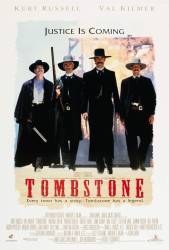Trivia: Val Kilmer is widely believed to be the most historically accurate portrayal of Doc Holliday. He is the same height, same build, and uses phrases used by Doc Holliday (eg "I'm your huckleberry" and "You're a daisy if you do").
Factual error: Three of the Earp brothers arrived in Tombstone on December 1, 1879. They served as lawmen during 1880/81 and fought the Cowboys in the famous gunfight on October 26, 1881, They left the area in April 1882. In the movie the Earps arrive in Tombstone in 1881 and ride past Boot Hill Cemetery. The tombstone displaying one of the most famous epitaph ever written is visible: "Here lies Lester Moore, Four slugs from a .44, No Les, No more." The problem is that Lester Moore wasn't killed until 1884. So it's impossible for his tombstone and famous epitaph to be in Boot Hill when the Earps arrived.
Suggested correction: Fact is nobody knows who Lester Moore is. They believe he was a mail clerk who was shot and killed over a dispute over a package, but they cannot prove it. There is no date on the tombstone, plus the fact that there was never anyone by that name ever killed in the Arizona territory makes this tombstone even more mysterious.
Factual error: During the gunfight in the lot behind the OK Corral, Tom McLaury is firing a six shooter at Doc just before Doc fires his shotgun in the air to scare Tom's horse away. The mistake is that Tom McLaury wasn't armed during the actual gunfight. He was shot by Doc while he was reaching for the rifle he had stored in his saddle. (01:14:58)
Suggested correction: The events have been intentionally adjusted by the filmmakers to create a coherent and entertaining movie. It is not a documentary. This film is loosely based on true events; it's not a day-to-day account of the events of 1880 through 1882. Artistic license does not constitute a movie mistake.
Changing facts in historical material does constitute factual mistakes, whether anybody wants to call them that or not.
It really depends on the degree to which the film-maker alters the facts, and whether that alteration is glaring or changes the story line. For most, it doesn't. Tom got shot and Doc shot him. There is an implicit duty of the audience to "suspend disbelief" - an acknowledgment that it is impossible to get every small detail correct.
How does changing the facts make it a good movie? I guess it might entertain those who know nothing about the facts. But for those who have studied and read up on things, going way out of the story does little in making a good story. That is why I like "Wyatt Earp" MUCH more than "Tombstone." No, "Wyatt Earp" is not a documentary. It, too, has altered some facts. But, to me, it is much closer to the truth. Even some of the dialog is from the Tombstone Epitaphs reporting of the incident.
Visible crew/equipment: In the opening sequence where Curly Bill and gang are walking toward the church, a microphone with a furry wind sock can be seen in the lower left just before Ike Clanton passes.
Suggested correction: Correction. That's not a microphone wind sock. That's a gourd. Used when empty to hold liquids. Look close, you can see it swinging from twine rope.
Continuity mistake: During the fight at the OK corral, Doc Holiday has a double barrel shotgun but he shoots it three times, once in the air to spook the horse, once again to shoot the guy behind the horse, then the scene changes and he shoots another guy with the same gun without reloading.
Suggested correction: This is already explained in corrections. The "third shot" is the same as the second shot from a different angle. The mistake is that he changes how he shoots. However, the same guy is shot - and falls dead from each angle.
I don't buy the explanation. What would be the point of the filmmaker doing that when it's not done elsewhere in the movie, and why would the killing of the guy Doc shot be important enough to warrant a shot of it from two angles when none of the others were? No sale; still an error.






Suggested correction: But Hucleberry Finn appeared in Tom Sawyer in 1876 and was a bad influence on, or "made trouble' for Tom.
Not sure what this correction is trying to state, but "I'm you're Huckleberry" was slang in the late 1800's for "I'm your man" and didn't derive from Twain or Huck Finn. Twain uses the earlier slang meaning of huckleberry for Finn, meaning an inconsequential person, to establish Finn is a boy of lower extraction or degree than Tom Sawyer.
Bishop73